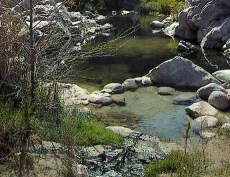October 5, 2007
BLM Issues Decision on Vegetation Treatment and Fuels Reduction Study
The Bureau of Land Management issued a decision today that will help improve the health of public lands by enhancing the agency’s ability to control and manage vegetation – including invasive and noxious weeds – and helping reduce fire-prone fuels, such as cheatgrass. The BLM’s decision – known as the Record of Decision for the Final Programmatic Environmental Impact Statement on vegetation treatment and fuels reduction – was developed on a national level to analyze the environmental effects of herbicides for treating and managing vegetation on Western public lands.
“Today’s decision is the result of extensive public participation and careful, comprehensive environmental study,” said BLM Director Jim Caswell. “We now have clear direction on using new but proven tools to support such important projects as the Healthy Lands Initiative.” (The Healthy Lands Initiative, as called for by the President in his Fiscal Year 2008 budget proposal, is aimed at restoring the health and productivity of the public lands at landscape levels.)
Published in today’s Federal Register, the BLM’s Record of Decision allows for the use of four new approved herbicides, provides updated analysis on 17 currently approved herbicides, and identifies those herbicides that the Bureau will no longer use on public lands. The decision also guides the use of herbicides for field-level planning and on-the-ground projects designed to restore and sustain important riparian, range, and wildlife habitat on public lands under BLM management. In addition, the decision establishes a protocol for assessing human health and ecological risks of future herbicide use. The decision issued today does not authorize any specific actions on the ground; site-specific analysis under the National Environmental Policy Act of 1969 is still required at the project level.
The BLM uses herbicides selectively and conservatively in combination with other treatment methods, such as mechanical or manual removal of vegetation and biological control, to achieve specific goals. Herbicide treatments can slow the spread of noxious weeds and invasive species, which in turn helps restore the natural role of fire and improves watershed function. For example, herbicide treatments help prevent exotic fire-prone annuals such as cheatgrass from out-competing reseedings of native vegetation. Similarly, spot treatment of weeds that had spread into a travel corridor support seeding with perennial grasses that provide better forage for wildlife and lower the risk of wildfire. Once the natural cycles and systems of an area are re-established, herbicide use can be reduced and eventually may be eliminated in favor of other, non-chemical means of control.
The text of the ROD as published in today’s Federal Register, along with more information on the use of herbicides as detailed in the BLM’s Final Programmatic Environmental Impact Statement, may be viewed online at http://www.blm.gov/wo/st/en/prog/more/veg_eis.html . Copies of the ROD may also be viewed in electronic and printed form in BLM Field Offices. Additional printed copies of the ROD will be available by mail upon request.
The BLM manages more land – 258 million surface acres – than any other Federal agency. Most of this public land is located in 12 Western states, including Alaska. The BLM, with a budget of about $1.8 billion, also administers 700 million acres of sub-surface mineral estate throughout the nation. The Bureau’s multiple-use mission is to sustain the health and productivity of the public lands for the use and enjoyment of present and future generations. The BLM accomplishes this by managing such activities as outdoor recreation, livestock grazing, mineral development, and energy production, and by conserving natural, historical, and cultural resources on the public lands.
Contacts:
Heather Feeney, 202-452-5031
Brian Amme, 775-861-6645
Gina Ramos, 202-452-5084
-- BLM --
Decision on Vegetation Treatment and Fuels Reduction
All posts are those of the individual authors and the owner
of this site does not endorse them. Content should be considered opinion
and not fact until verified independently.
| Subject | Author | Views | Posted |
|---|---|---|---|
| Rick | 1550 | October 13, 2007 12:51PM |
Sorry, only registered users may post in this forum.



